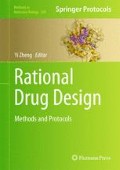Abstract
Ganglioside GD2 is a cell surface glycosphingolipid that is targeted clinically for cancer diagnosis, prognosis, and therapy. The conformations of free GD2 and of GD2 bound to anti-GD2 mAb 3F8 were resolved by saturation transfer difference nuclear magnetic resonance and molecular modeling. Then small molecule cyclic peptide ligands that bind to GD2 selectively were designed, and shown to affect GD2-mediated signal transduction. The solution structure of the GD2-bound conformation of the peptide ligands showed an induced-fit binding mechanism. This work furthers the concept of rationally designing ligands for carbohydrate targets; and may be expanded to other clinically relevant gangliosides.
These two authors contributed equally in this chapter.
Access this chapter
Tax calculation will be finalised at checkout
Purchases are for personal use only
References
Pellecchia M, Bertini I, Cowburn D, et al. Perspectives on NMR in drug discovery: a technique comes of age. Nat Rev Drug Discov. 2008;7:738–45.
Meyer B, Peters T. NMR spectroscopy techniques for screening and identifying ligand binding to protein receptors. Angew Chem Int Ed Engl. 2003;42:864–90.
Markwick PR, Malliavin T, Nilges M. Structural biology by NMR: structure dynamics and interactions. PLoS Comput Biol. 2008;4:e1000168.
Tong W, Gagnon M, Sprules T, et al. Small-molecule ligands of GD2 ganglioside designed from NMR studies exhibit induced-fit binding and bioactivity. Chem Biol. 2010;17:183–94.
Modak S, Cheung NK. Disialoganglioside directed immunotherapy of neuroblastoma. Cancer Invest. 2007;25:67–77.
Hakomori S-I, Zhang Y. Glycosphingolipid antigens and cancer therapy. Chem Biol. 1997;4:97–104.
Birklé S, Zeng G, Gao L, et al. Role of tumor-associated gangliosides in cancer progression. Biochimie. 2003;85:455–63.
Jayalakshmi V, Krishna NR. Complete relaxation and conformational exchange matrix (CORCEMA) analysis of intermolecular saturation transfer effects in reversibly forming ligand-receptor complexes. J Magn Reson. 2002;155:106–18.
Saragovi HU, Greene MI, Chrusciel RA, Kahn M. Loops and secondary structure mimetics: development and applications in basic science and rational drug design. Biotechnol (N Y). 1992;10:773–8.
Sonnino S, Cantù L, Corti M, et al. Aggregative properties of gangliosides in solution. Chem Phys Lipids. 1994;71:21–45.
Yan J, Kline AD, Mo H, et al. The effect of relaxation on the epitope mapping by saturation transfer difference NMR. J Magn Reson. 2003;163:270–6.
Wang J, Wang W, Kollman PA, Case DA. Automatic atom type and bond type perception in molecular mechanical calculations. J Mol Graph Model. 2006;25:247–60.
Case DA, Cheatham 3rd TE, Darden T, et al. The Amber biomolecular simulation programs. J Comput Chem. 2005;26:1668–88.
Rieping W, Habeck M, Bardiaux B, et al. ARIA2: Automated NOE assignment and data integration in NMR structure calculation. Bioinformatics. 2007;23:381–2.
Feig M, Karanicolas J, Brooks CL. MMTSB Tool Set: enhanced sampling and multiscale modeling methods for applications in structural biology. J Mol Graph Model. 2004;22:377–95.
Delaglio F, Grezesiek S, Vuister GW, et al. NMRpipe: a multidimensional spectral processing system based on UNIX pipes. J Biomol NMR. 1995;6:277–93.
Houliston RS, Yuki N, Hirama T, et al. Recognition characteristics of monoclonal antibodies that are cross-reactive with gangliosides and lipooligosaccharide from Campylobacter jejuni strains associated with Guillain-Barre and Fisher syndromes. Biochemistry. 2007;46:36–44.
Bernatchez S, Szymanski CM, Ishiyama N, et al. A single bifunctional UDP-GlcNAc/Glc 4-Epimerase supports the synthesis of three cell surface glycoconjugates in Campylobacter jejuni. J Biol Chem. 2005;280:4792–802.
Blixt O, Vasiliu D, Allin K, et al. Chemoenzymatic synthesis of 2-azidoethyl-ganglio-oligosaccharides GD3, GT3, GM2, GD2, GT2, GM1, and GD1a. Carbohydr Res. 2005;340:1963–72.
Mayer M, Meyer B. Group epitope mapping by saturation transfer difference NMR to identify segments of a ligand in direct contact with a protein receptor. J Am Chem Soc. 2001;123:6108–17.
Siebert HC, Reuter G, Schauer R, et al. Solution conformations of GM3 ganglioside containing different sialic acid residues as revealed by NOE-based distance mapping molecular mechanics and molecular dynamics calculations. Biochemistry. 1992;31:6962–71.
Jakalian A, Jack DB, Bayly CI. Fast efficient generation of high-quality atomic charges AM1-BCC model: II Parameterization and validation. J Comput Chem. 2002;23:1623–41.
Naim M, Bhat S, Rankin KN, et al. Solvated interaction energy (SIE) for scoring protein-ligand binding affinities. 1. Exploring the parameter space. J Chem Inf Model. 2007;47:122–33.
Coley AM, Parisi K, Masciantonio R, et al. The most polymorphic residue on Plasmodium falciparum apical membrane antigen 1 determines binding of an invasion-inhibitory antibody. Infect Immun. 2006;74:2628–36.
Muller R, Debler EW, Steinmann M, et al. Bifunctional catalysis of proton transfer at an antibody active site. J Am Chem Soc. 2007;129:460–1.
Author information
Authors and Affiliations
Corresponding author
Editor information
Editors and Affiliations
Rights and permissions
Copyright information
© 2012 Springer Science+Business Media New York
About this protocol
Cite this protocol
Tong, W., Sprules, T., Gehring, K., Saragovi, H.U. (2012). Rational Design of Peptide Ligands Against a Glycolipid by NMR Studies. In: Zheng, Y. (eds) Rational Drug Design. Methods in Molecular Biology, vol 928. Humana Press, Totowa, NJ. https://doi.org/10.1007/978-1-62703-008-3_4
Download citation
DOI: https://doi.org/10.1007/978-1-62703-008-3_4
Published:
Publisher Name: Humana Press, Totowa, NJ
Print ISBN: 978-1-62703-007-6
Online ISBN: 978-1-62703-008-3
eBook Packages: Springer Protocols

